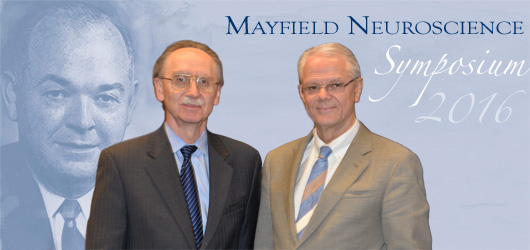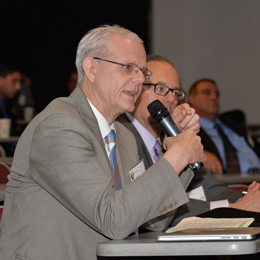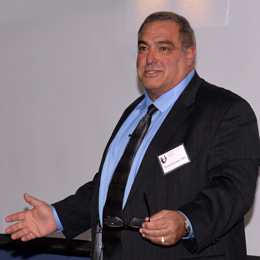
James T. Rutka, MD, PhD, the R.S. McLaughlin Professor & Chair of the Department of Surgery at the University of Toronto and Editor-in-Chief of the Journal of Neurosurgery, on Friday gave a hopeful overview of progress that is being made in the treatment of what he called “the worst tumor in humans.”
Speaking as the Mayfield Lecturer at the 33rd Mayfield Neuroscience Symposium at the University of Cincinnati College of Medicine, Dr. Rutka outlined two significant developments that are being made in the quest to treat diffuse intrinsic pontine glioma (DIPG), the brain cancer that took the life of Lauren Hill, the 19-year-old basketball player from Mount St. Joseph.

Dr. Rutka called it “the worst” because it occurs in children and adolescents and has a median survival of only 12 to 18 months. “Nothing works,” Dr. Rutka said. “Radiation fails. Chemotherapy fails. And there is a limited role for surgery.”
DIPG, which is diagnosed a few hundred times a year in North America, is one of a constellation of pediatric tumors that develop on the brainstem that were once considered inaccessible. “They are among the smallest tumors in the body that can kill you” Dr. Rutka said.
But scientists, including those at the University of Toronto, have made two key inroads. In 2014, four separate papers published in Nature Genetics identified a DIPG biomarker: mutations in the ACVR1 gene that are found in some DIPG tumors. The mutation, Dr. Rutka said, “is now a target for a new drug or agent that may stop DIPG.”
Meanwhile, researchers have developed a revolutionary technique for successfully delivering cancer drugs through the blood brain barrier, which nature designed to keep chemical intruders out.
In a mouse model, researchers at the University of Toronto inject microbubbles into the bloodstream, followed by gold nanoparticles that carry an anti-cancer drug on their surface. The researchers then apply focused ultrasound, which triggers swelling of the microbubbles. Bumping against the blood brain barrier, the microbubbles create a temporary microscopic breech of the barrier. This allows the drug-laced nanoparticles to escape into the brain tissue, where they bind to the surface of cancer cells, trigger cell death, and reduce the size of the tumor.
“This process allows for an egress of chemotherapy that normally cannot cross the blood brain barrier,” Dr. Rutka said. “We have created a model whereby the nanoparticles can now enter the brainstem, and specifically the pons.”
In essence, researchers are outsmarting the blood brain barrier.
The ultrasound therapy is now being tested in brain metastases and recurrent glioma in adults. But with a note of caution, Dr. Rutka added: “The elephant in the room is this: Do you create a risk of intracranial hemorrhage by breaking down the blood brain barrier? The risk of hemorrhage has become less with technological refinements. We’re now using microbubble techniques that allow the intensity from the ultrasound to come way down. And because this is being used in adults, it could translate quickly into children.” (The technique is currently being used for bone tumors, but not brain tumors, in children at the University of Toronto).
The upshot, Dr. Rutka said, is a future that “looks promising for disease where we’ve gone nowhere in the last 30 years.”
Graduation honors

The Mayfield Symposium coincided with graduation ceremonies for three neurosurgery residents from the UC College of Medicine: Daniel Harwell, MD, Ryan Tackla, MD, and Jonathan York, MD. Steven Gogela, MD, a fifth-year resident, was named the 2016 winner of the Ellen and Stewart B. Dunsker, MD, Award for Clinical Research. Jennifer Kosty, MD, a fourth-year resident, was honored with the John M. Tew, Jr., MD, Award for Neuro-Oncology Research.
The event also featured Alumnus Lecturer Daniel J. Scodary, MD, Medical Director at SSM Health Neuroscience in St. Louis. Dr. Scodary’s lecture was titled, “Sacroiliitis: Do We Continue to Ignore It?”
Reputation and scientific integrity
The topic of Dr. Rutka’s second lecture was “Scientific Integrity: Why it Matters.”
Science, built on a foundation of trust, cannot tolerate fabrication, falsification, plagiarism, or ethical violations, Dr. Rutka said. He quoted a Plos One study that found that 2 percent of scientists acknowledged falsifying research and 34 percent admitted to other questionable research practices. Falsification, he said, can include the “manipulation of research materials, equipment, or processes” or the “manipulation on an image to state there is overexpression of a gene.”
Scientific misconduct, he said, includes faulty reporting of outcomes, conclusions not supported by data, plagiarism, conflicts of interest, failure to obtain approval from a research ethics board, inappropriate authorship listings, and failure to follow university and hospital policies.
He warned residents in the audience that plagiarism is easily revealed. He said that a young physician whose career is marred by research misconduct will struggle to move forward and gain promotions in his or her field. Regarding scientific misconduct, he concluded, “Just don’t do it!”
Looking beyond statistics
Stewart Dunsker, MD, Professor Emeritus of Neurosurgery and a retired Mayfield neurosurgeon, provided his annual words of wisdom in announcing the Dunsker Award, which he underwrites with his wife, Ellen. Doctors, he said, should not deduce what happens to patients only by looking at large numbers. “Those are statistics,” he said. “What happens to you and your patient is not a statistic: it’s a tragedy. We look at averages to better understand what happens to the patient; [but] I implore you to continue to look at your patients and not just the statistic.”
— Cindy Starr